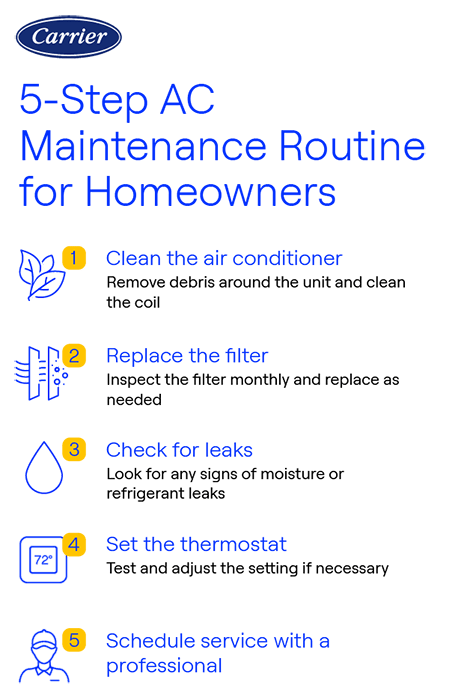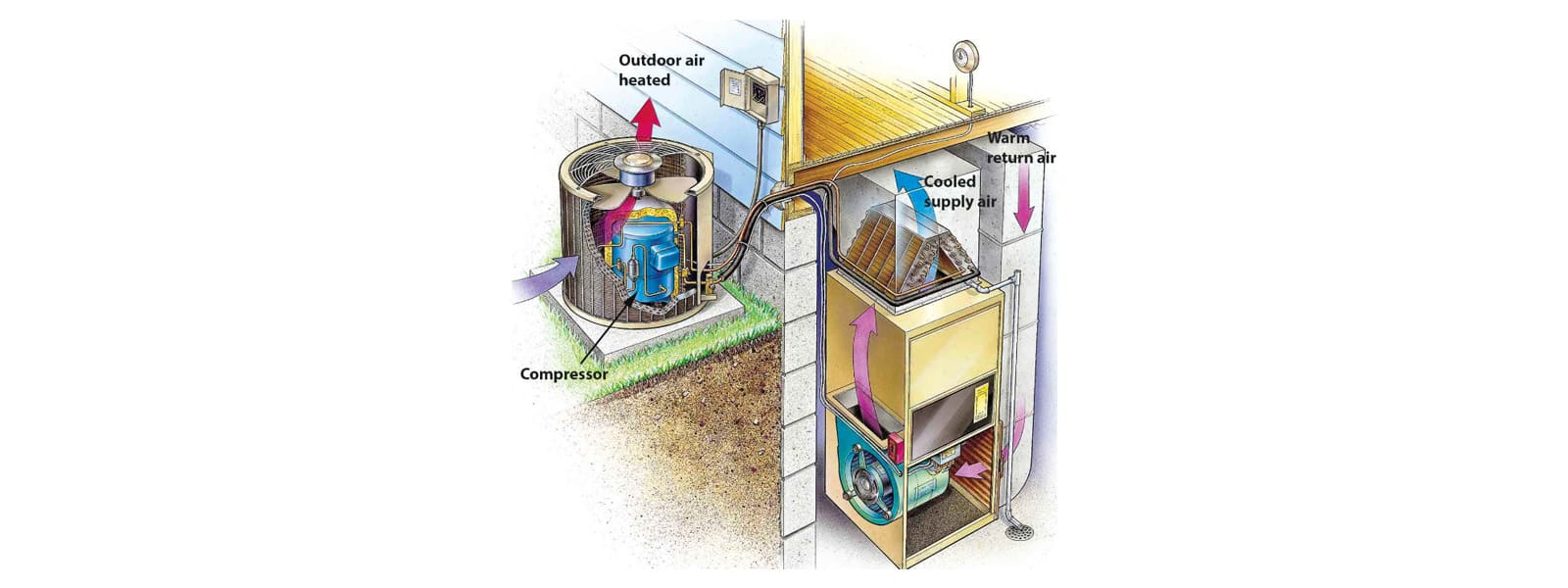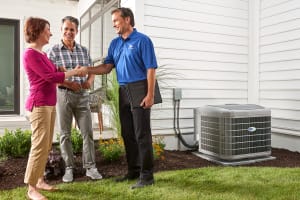5 Air Conditioner (AC) Maintenance Tips You Should Know
By Ryan Mayes
Find a Carrier expert nearby to help with your air conditioner maintenance.

Most car owners understand how regular maintenance like oil changes, tire rotations and filter changes can go a long way towards maximizing performance. It’s a small price to pay to extend the life of the vehicle. The same goes with air conditioners. And, understanding the value of air conditioner maintenance means understanding a little more about how your air conditioning unit works.
Why is Annual AC Maintenance Important?
Regular AC maintenance and tune-ups can minimize many of the issues caused by build-up of dirt and debris. If they are performed by an HVAC technician, these inspections allow your contractor to check for longer-term issues and in some cases take proactive steps to prevent premature failure or inconvenient breakdowns during the cooling season.
Annual air conditioner preventative maintenance can not only increase energy efficiency, but may also be a requirement to keep your warranty valid as well. Many manufacturers state on warranty documentation that AC installation and maintenance by a licensed HVAC professional are a part of the warranty conditions.
5-Step AC Maintenance Routine for Homeowners

One of the most effective ways to save money on professional AC maintenance is by taking proactive steps to care for your unit yourself. Regularly keeping your air conditioner free from leaves and other debris, changing its filters, and ensuring that it is serviced annually by a professional can significantly extend its lifespan, enhance its efficiency, and help prolong the period until an AC replacement is needed. These simple air conditioner maintenance tips can prevent more costly repairs and reduce the need for emergency service calls. By keeping your unit well-maintained, you not only save on the costs associated with professional services but also benefit from reduced cooling bills due to more efficient operation.
1. Clean the Air Conditioner
One simple way to potentially save money and prolong the life of an AC system is to make sure the outdoor unit stays clean. During normal operation, a fan in the outdoor unit pulls air through the condenser coil. Airborne dust and dirt particles and debris from nearby foliage can get lodged in the coil fins, restricting airflow and affecting performance. Four air conditioner preventative maintenance tasks that can keep the outdoor unit clean:
- Removing debris/foliage: Trim back or clear the area of shrubs or flowers that can restrict airflow to the unit. Physically remove any leaves or other debris that has accumulated near the base of the unit or is clinging to the side of the unit.
- Vacuum the coil fins: Your dealer will turn off the system either at the thermostat, the power cutoff near the outdoor unit, or the breaker box. Once they have ensured the system is disconnected from power, they will vacuum the coil, which wraps around most of the outside of the unit using a soft bristle brush attachment. Most AC coils are composed of refrigerant tubing and thin metal “fins” that bend easily. Your dealer will be careful not to bend the fins as this can also restrict airflow and affect performance.
- Cleaning the coil fins: Your dealer will turn off the system either at the thermostat, the power cutoff near the outdoor unit, or the breaker box. Once they have ensured the system is disconnected from power, they will clean the coil fins with coil-cleaning chemicals and using a garden hose (NOT use a power washer – too much pressure can bend or damage the fins), they will gently rinse dirt and debris from the coil starting at the top and moving down.
- Cleaning the evaporator coil: The indoor evaporator coil also requires airflow for proper operation, but because it is typically difficult to access, we recommend leaving cleaning AC coils to a licensed Carrier indoor comfort expert.
- Clean the condensate drains: To clean the condensate drain, first, locate the drain line and remove any visible debris. Then, use a wet/dry vacuum or a small, flexible brush to clear any clogs inside the line. It's important to clean the condensate drain regularly to prevent water backup, which can lead to mold in the AC unit, system malfunctions, and water damage to your home, ensuring your AC runs smoothly and efficiently.
2. Replace the Filter
One of the easiest air conditioner preventative maintenance tasks you can perform yourself is to clean or replace your system’s air filter. The air filter for your AC system will be located in or near your indoor unit. Whether it is a basic 1-inch filter, a larger, 4-inch media filter or a more sophisticated electronic air cleaner or purifier, the filter should be cleaned or replaced periodically. These air conditioner filters can help with indoor air quality by removing airborne particles and pollutants from your home. They can also help keep your system operating at its peak performance by reducing the buildup of dust, dirt and other particles from accumulating on internal components like the blower motor.
How often to change air conditioner filters depends on a number of factors:
- The quality and type of filter
- Environmental issues such as pets and smoke from a fireplace, tobacco or cooking
- If you or family members suffer from allergies or asthma
- How often the system runs due to thermostat settings/personal preferences
- Use of constant fan for air circulation
It’s a good idea to check and inspect your filter at least once every 2-3 months. Some filters, such as the wider 4-inch media filters can last up to 1 year before replacing. Whenever possible, follow your manufacturer’s recommendations for filter maintenance. In general, to clean or replace your AC system filter, follow these steps:
- Turn off system power at the thermostat, the breaker box, or the power shutoff switch located on/near the indoor unit.
- The exact location of the filter can vary depending on the indoor unit. Look for the filter along the sides, top or bottom of the blower cabinet. The filter may be positioned horizontally or vertically, depending on the model. Or in some cases, especially on older models, the filter may be found inside the blower cabinet.
- Once you have ensured the system is disconnected from power, remove and inspect the filter for excessive dust buildup or debris. Clean the filter with a vacuum attachment or replace with a new filter.
- Make sure the filter is positioned properly and that the airflow arrows are pointing in the correct direction.
- Replace the cabinet cover and restore power.
3. Check for Leaks
4. Set the Thermostat
Ensuring your thermostat is set properly is a key step in maintaining your AC system and keeping your home comfortable. If the thermostat is set too low or too high, the air conditioning unit may work harder than necessary, leading to unnecessary wear and tear and higher cooling bills. Proper temperature settings help the system maintain a consistent indoor climate without overworking, ultimately extending the lifespan of the unit and reducing the need for repairs. A smart thermostat can further optimize your system by automatically adjusting temperature settings based on your preferences and schedule. By learning your habits, it helps reduce unnecessary energy usage, ensuring efficient air cooling and lowering maintenance costs over time.
5. Schedule Annual Service by a Professional
Ensuring your air conditioner is well-maintained in the spring can significantly enhance the performance and efficiency of your heating system during the colder months. One important step is to schedule a professional HVAC maintenance check in the spring with your local Carrier dealer; this not only ensures your AC is ready for the summer but also confirms that it's in good shape to support your furnace in the winter.

Figure 1: Sample Diagram of Air Conditioner
Know When to Call a Professional For AC Maintenance
While it’s true that a regular AC tune up can help prolong the life expectancy of your air conditioning system... and there are a handful of DIY maintenance tasks that can be performed by an average homeowner... there are times when it’s just best to call a certified HVAC technician. Some signs that it may be time to search for AC maintenance near me include:
- HVAC system is not cooling adequately or not running at all
- HVAC system is constantly running for long periods of time
- HVAC system turns on and off frequently
- Copper refrigerant tubing or outdoor coil showing signs of icing up or freezing
If you are experiencing any of the above issues, a trained technician can further evaluate your cooling system during their air conditioner maintenance visit. If you don’t have trusted contractor in mind, follow the link to our dealer locator to find AC maintenance near you.
You may also visit our air conditioner repair page for more information or our mini split ac repair and troubleshooting guide.
What Does Professional AC Maintenance Include?
When a professional technician conducts AC maintenance, the service typically covers a comprehensive check and tune-up of your system to ensure it is running efficiently and effectively. The technician will start by changing the air filters, which can improve air quality and enhance the system's efficiency. They'll also check the thermostat to ensure it's accurately gauging and controlling the temperature. Additionally, tightening electrical connections is a critical step to prevent potential safety hazards and improve the unit's reliability. Here are some additional tasks usually included in an AC maintenance service:
- Inspect and clean the condenser coils to ensure they are not hindering the system’s efficiency.
- Check refrigerant levels, check for refrigerant leaks and recharge if necessary, to keep the system running smoothly without overworking.
- Clean and adjust the blower components to ensure proper airflow and enhance the system’s overall efficiency.
- Examine ductwork for leaks which can lead to energy losses and reduced system effectiveness.
- Lubricate motors and bearings to reduce friction and prevent overheating or wear.
- Test the system's controls and safety mechanisms to ensure they are functioning correctly, providing safe operation.
- Clear the condensate drain line to prevent water backup and potential water damage or humidity issues.
How Long Does AC Maintenance Take?
The complete AC maintenance process usually lasts between 1-2 hours, but this duration may vary based on the system's condition and the specific maintenance tasks needed. Air conditioning professionals advise having a comprehensive service performed every 12 months to maintain peak performance and extend the life of your system. It is recommended to schedule this service in the early spring, before temperatures begin to rise, ensuring your system is prepared for the hotter months ahead.
How Much Does AC Maintenance Cost?
On average, the cost of professional AC maintenance can range between $65 to $200.1 This variation in price depends on geographic location, the complexity of the system, and the specific services included in the maintenance package. Regular maintenance not only helps in reducing emergency repairs but also contributes to more efficient energy use, which can help save money on heating and cooling bills in the long run. Ensure your system is always running at its best by scheduling your next maintenance check. Find a dealer today and set up an appointment.
1https://www.thisoldhouse.com/heating-cooling/reviews/ac-tune-up-cost
Frequently Asked Questions About AC Maintenance
Air conditioner maintenance includes filter replacement, evaporator coil and condenser coil cleaning, and professional tasks such as drain line maintenance and the inspection of ductwork, refrigerant levels, electrical components, and system performance.
It is recommended to have a professional HVAC technician perform a comprehensive inspection and tune-up once a year to inspect your system and its operation.
Learn More About AC Maintenance
- How to fix a Clogged AC Drain Line
- Discover causes of an AC short cycling
- Learn why is my AC blowing hot air?
- Understand why does my AC smell?
- Learn about frozen AC coils
- Discover the reasons for an AC leaking water
- Learn what to do if you have mold in AC unit




